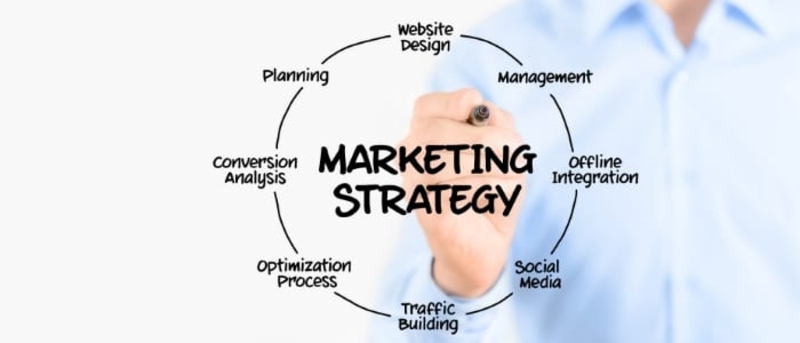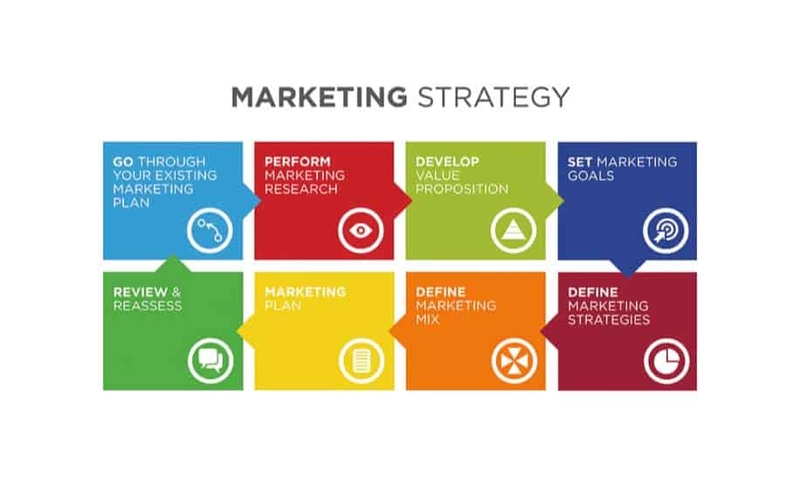Understanding Marketing Strategy and Its Importance
May 19, 2024 By Triston Martin
A marketing strategy is like a detailed road map made to reach certain business objectives using planned marketing actions. It shows what steps a company needs to take to get into the eyes and minds of its intended customer group, setting itself apart from other similar businesses as well as creating strong awareness about its brand. The basics of what this strategy includes, how good it is in producing results, and ways companies can apply it successfully are discussed in the article.
Defining Marketing Strategy
The marketing strategy for a company is similar to a blueprint, as it provides direction and purpose to the marketing efforts. This plan sets out details such as which market groups are being targeted, what makes this business different from others (unique value proposition), and how best it can communicate with possible customers (channel selection). A clear marketing strategy helps in coordinating the actions of marketing with main business goals so that each effort has an impact on overall target achievement. It involves different parts like studying the market, finding a place for the product in it, deciding on prices, and making promotions to get and keep customers.

Furthermore, a marketing strategy needs to be in line with the business aims and should include an analysis of competition and knowing the market situation. This type of study can help locate market voids that the company can fill. A good strategy not only brings in new clients but also concentrates on keeping them by creating lasting connections and nurturing loyalty through ongoing communication that offers value.
- Market Insights: Regularly update market research to stay ahead of industry trends and shifts.
- Customer Focus: Tailor marketing efforts to meet the evolving needs and preferences of your target audience.
Key Components of a Marketing Strategy
Good marketing strategies are based on a strong comprehension of the market and what customers require. The market study is an important part, giving knowledge about consumer actions, likes/dislikes, and tendencies in buying habits among other things. This information aids businesses in finding chances or threats present in their chosen markets. Another necessary part is the value proposition, which shows what special advantages a product or service has. This proposition must get passed on very clearly so it can stand apart from other similar offerings in the market. Also, picking suitable marketing channels such as social media platforms, email communication methods or traditional ads is very important to effectively reach the group you are targeting.
Apart from market research and value proposition, another important part is segmentation. It splits the market into several groups of consumers who have similar needs or features. This helps to make marketing more focused and efficient. Also, by setting up clear goals for marketing that are possible to achieve we can give direction and benchmarks for measuring success. When integrated marketing communications are put into action, it helps to make sure that the message is kept consistent through all channels and this improves brand coherence and recognition.
- Segmentation: Divide your market into specific segments to tailor marketing messages effectively.
- Integrated Communications: Ensure all marketing channels deliver a consistent and unified message.
How a Marketing Strategy Works
To put a marketing strategy into action, there needs to be a sequence of planned activities that are carried out with purpose. This starts with defining objectives that can be measured and are in line with the business goals. The objectives might involve things like raising consciousness about the brand, creating possible customers, or increasing sales. After objectives are made, we must create an action plan. This plan details the particular tactics to use, when they will be implemented, and how success will be measured - with regular monitoring and analysis being key for checking if our strategy works well or needs changes.
One important part of how a marketing strategy functions is the distribution and use of resources. This includes people, money, technology, and data analytics to make sure the plan runs smoothly. Communication is also very crucial for both inside marketing teams and with other parts of the company so that everyone understands what needs to be done. Tweaks that are made from feedback and performance data assist in perfecting the strategy, guaranteeing its importance and usefulness in accomplishing set goals.
- Resource Allocation: Allocate adequate resources to support the implementation of marketing tactics.
- Data Analytics: Use analytics tools to track performance and refine strategies based on data insights.
Evaluating the Effectiveness of a Marketing Strategy
For continuous improvement, it is very important to measure how well a marketing strategy works. Key performance indicators (KPIs), like conversion rates, customer acquisition cost, and return on investment (ROI) can give a useful understanding of the success of marketing efforts. By checking these metrics often, you can find out what works and what doesn't work well. This helps businesses make their strategies better. Another type of data, which is not numerical but descriptive, can come from surveys and feedback given by customers about how well the marketing message connects with its intended recipients. When these types of information are used together with statistical analysis, it helps companies to adjust their plans for better outcomes.
Evaluation likewise includes competitor benchmarking, where businesses can compare their performance with industry standards and competitors. This helps them understand what areas they are leading or lagging in. Regular audits of marketing activities check if they are aligned with the strategy and reveal any deviations or inefficiencies. The data-based choices and quick adjustments to findings from these evaluations help keep the marketing strategy up-to-date and efficient.
- Competitor Benchmarking: Compare your performance with industry standards and competitors.
- Regular Audits: Conduct periodic audits to ensure alignment with marketing strategy and uncover inefficiencies.
Steps to Implement a Marketing Strategy
To set up a marketing strategy, you need to follow systematic steps. First is doing a complete market analysis to know the competition and what customers require. After this understanding, businesses can explain their aim market and create a special value offering. After, it is important to establish precise, quantifiable goals and make a detailed plan of action. This should cover the methods of marketing, budget, and time frame for carrying out tasks. The process is also about managing and adjusting as needed. Checking performance metrics and making adjustments keeps the strategy in line with business goals and market changes.

A very important step is making sure there's collaboration across functions in the organization as marketing strategies usually need ideas and cooperation from different departments like sales, product making, and service to customers. Good communication and training for all team members involved in the strategy are very important so that everyone knows what they have to do. It's also crucial to adjust fast when receiving feedback or seeing changes in market conditions for a successful implementation of this plan; it keeps your strategy flexible and adaptable at all times.
- Cross-Functional Collaboration: Ensure cooperation between different departments for cohesive strategy execution.
- Adaptability: Be prepared to adapt the strategy based on feedback and market changes swiftly.
Challenges in Implementing Marketing Strategies
Regardless of how well you plan, different difficulties can be encountered in putting into action a marketing strategy. A normal problem is not having clear communication and organization between team members which causes mixed-up messages and resource loss. Another difficulty is the adjustment to changes in market conditions. It is possible that consumer likes and competitive situations change quickly, necessitating businesses to be flexible and quick in their response. Also, there may be limitations on resources which could include budget restrictions or not having enough knowledge about certain aspects of marketing strategy implementation. To handle these difficulties, project management must be strong, we need to keep learning and show a readiness for innovation and adjustment.
Additional difficulties involve handling stakeholder anticipations and coping with unexpected elements from outside like economic recessions or adjustments in regulations. It is crucial to retain adaptability in the strategy for managing these difficulties properly. Frequent schooling and progress schemes can assist the marketing team in keeping up with the newest trends and technologies. Top management support and engagement can also be very crucial for handling these difficulties. It gives the needed resources and strategic path.
- Stakeholder Expectations: Manage expectations through clear communication and regular updates.
- External Factors: Maintain flexibility to address external factors like economic shifts or regulatory changes.
Conclusion
In conclusion, a good marketing strategy is crucial for any business that wants to reach its objectives and keep growing in the long run. If you grasp what a marketing strategy means - how it functions plus the stages needed to put one into action successfully - then your firm will be more prepared to handle market intricacies. This thorough guide gives you the basis to create, carry out, and improve marketing strategies that lead to triumph. By making thoughtful plans, ongoing evaluations, and adjustments, companies can make their brands robust and have a big effect on the market.

Comprehensive AIG Life Insurance Review: What You Need to Know
Explore a detailed review of AIG's life insurance offerings, including term, whole, and universal life policies, their financial stability, customer service, and application process.
May 09, 2024 Triston Martin

All About Parent PLUS Loans
In comparison to a 7(a) loan, SBA Express loans have fewer requirements. The essential qualifications for both 7(a) loans and Express loans are the identical, and both types of loans can be used for things like working capital, equipment finance, and debt consolidation. However, there are key distinctions between Express loans and 7(a) loans
Feb 21, 2024 Susan Kelly

Homeownership and Credit Rating – Everything You Need to Know
If you Want to learn about the impact of homeownership and credit score, dive into this article, as it has everything you need to know.
Jan 13, 2024 Triston Martin

What Exactly Are Tax Brackets? An Explainer for the Financially Curious
Discover how understanding tax brackets, effective tax strategies, and smart planning can significantly reduce your tax burden and enhance financial health.
Mar 22, 2024 Susan Kelly

Decoding Stash vs. Robinhood: Unveiling the Best Investment Platform for You
Dive into the Stash vs. Robinhood 2023 comparison to discover which investing platform suits you best. Explore their features, fees, and services to make an informed choice in your financial journey.
Dec 14, 2023 Triston Martin

Ways To Manage Your Bank Accounts When Self-Employed
The ability to set your hours, work from various places and take time off whenever convenient all come with the territory when you're your boss. When you are your own boss, you are responsible for various responsibilities, including managing your company's finances, creating and adhering to a budget, and preparing to fulfil any applicable tax obligations
Jan 27, 2024 Triston Martin